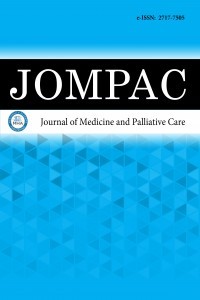Büyük veya komplike abdominal hernilerin tedavisinde anterior kompenent seperasyon tekniği etkili mi?
Komplike büyük herni, Anterior kompenent seperasyon tekniği, Nüks, Komplikasyon
Büyük veya komplike abdominal hernilerin tedavisinde anterior kompenent seperasyon tekniği etkili mi?
Complicated large hernia, Anterior component separation technique, Recurrence, Complication,
___
- Dan H, Shell IV, de la Torre J, Andrades P, Vasconez LO. Open repair of ventral incisional hernias. Surg Clin N Am 2008; 88: 61–83.
- Topcu R. İnsizyonel Hernilerde Kompenent Seperasyon Tekniği. Gök MA, Kafadar MT (ed). Fıtık Cerrahisi 1. Baskı 2020: 159-79.
- Jin J, Rosen MJ. Laparoscopic versus open ventral hernia repair. Surg. Clin. North Am 2008; 88: 1083-100.
- Klinge U, Conze J, Krones CJ, Schumpelick V. Incisional hernia: open techniques . World J. Surg 2005; 29: 1066-2.
- Usher FC, Ochsner J, Tuttle Jr LL. Use of marlex mesh in the repair of incisional hernias.Am. Surg 1958; 24: 969-4.
- Eriksson A, Rosenberg J, Bisgaard T. Surgical treatment for giant incisional hernia: a qualitative systematic review. Hernia 2014; 18: 31-8.
- Pauli EM, Rosen MJ. Open ventral hernia repair with component separation. Surg Clin North Am 2013; 93: 1111-33.
- De Vries Reilingh TS, van Goor H, Charbon JA, et al. Repair of giant midline abdominal wall hernias: "components separation technique" versus prosthetic repair: interim analysis of a randomized controlled trial. World J Surg 2007; 31: 756-3.
- Ramirez OM, Ruas E, Lee Dellon A. Component separation method for closure of abdominal wall defects: An anatomic clinical study. Plast Reconstr Surg. 1990; 86: 519–6.
- De Vries Reilingh TS, van Goor H, Rosman C, et al. Component separation technique for the repair of large abdominal wall hernias. J Am Coll Surg 2003; 196: 32–7.
- Van Geffen HJ, Simmermadner RK, van Vroonhoven TJ, van der Werken C. Surgical treatment of large contaminated abdominal wall defects. J Am Coll Surg 2005; 201: 206–2.
- Liang MK, Holihan JL, Itani K, et al. Ventral hernia management: expert consensus guided by Systematic Review. Ann Surg 2016.
- Trehan M, Aggarwal K, Singh J, Singla S, Garg R. Evaluation of the component separation technique for the treatment of patients with large incisional hernia. Int J Appl Basic Med Res 2021; 11: 40-3.
- Jensen KK, Arnesen RB, Christensen JK, Bisgaard T, Jørgensen LN. Large ıncisional hernias ıncrease in size. J Surg Res 2019; 244: 160-5.
- Azar FK, Crawford TC, Poruk KE, et al. Ventral hernia repair in patients with abdominal loss of domain: an observational study of one institution's experience. Hernia 2017; 21: 245-2.
- Lindmark M, Strigård K, Löwenmark T, Dahlstrand U, Gunnarsson U. Risk factors for surgical complications in ventral hernia repair. World J Surg 2018; 42: 3528-6.
- Kesicioglu T, Yildirim K, Yuruker S, et al. Three-year outcome after anterior component separation repair of giantventral hernias: A retrospective analysis of the original technique without mesh, Asian J Surg 2021.doi.org/10.1016/j.asjsur.2021.08.017.
- Pereira-Rodriguez, JA, Bravo-Salva A, Montcusí-Ventura B, et al. Early outcomes of component separation techniques: an analysis of the Spanish registry of incisional Hernia (EVEREG). Hernia 2021; 25: 1573–0.
- Samir M, Hany M, Ibrahim M. Evaluation of component separation technique in the repair of complex large ventral hernia with large defects. Egypt J Surg 2015; 34: 272–5.
- Gonzalez R, Rehnke RD, Ramaswamy A, et al. Components separation technique and laparoscopic approach: a review of two evolving strategies for ventral hernia repair. Am Surg 2005; 71: 598-5.
- Cornette B, De Bacquer D, Berrevoet F. Component separation technique for giant incisional hernia: a systematic review. Am J Surg 2015; 215: 719-6.
- Maloney SR, Schlosser KA, Prasad T, et al. Twelve years of component separation technique in abdominal wall reconstruction. Surgery 2019; 166; 435-4.
- Clarke JM. Incisional hernia repair by fascial component separation: results in 128 cases and evolution of technique. Am J Surg 2010; 200: 2-8.
- Köckerling F. Recurrent Incisional Hernia Repair-An Overview. Frontiers in Surgery 2019; 6: 26.
- Sailes FC, Walls J, Guelig D, Mirzabeigi M, et al. Synthetic biological mesh in component separation: A 10 yr. Single institution review. Ann Plast Surg 2010; 64: 696–8.
- Hultman CS, Tong WM, Kittinger BJ, Cairns B, Overby DW, Rich PB. Management of recurrent hernia after components separation: 10-Year experience with abdominal wall reconstruction at an academic medical center. Ann Plast Surg 2011; 66: 504–7.
- Moore M, Bax T, MacFarlane M, McNevin MS. Outcomes of the fascial component separation technique with synthetic mesh reinforcement for repair of complex ventral incisional hernias in the morbidly obese. Am J Surg 2008; 195: 575-9.
- Razavi SA, Desai KA, Thompson PW, Hart AM, Losken A. The impact of mesh reinforcement with components separation for abdominal wall reconstruction. Am Surg 2018; 84: 959–2.
- Sandvall BK, Suver DW, Said HK, et al. Comparison of synthetic and biologic mesh in ventral hernia repair using components separation technique. Ann Plast Surg 2016; 76: 674–9.
- Başlangıç: 2020
- Yayıncı: MediHealth Academy Yayıncılık
Kolorektal kanserlerin yeniden evrelemesinde F-18 FDG PET/BT’nin önemi
Alev ÇINAR, Esra Arzu GENCOGLU
Görme kaybı ve serebral apse ile seyreden geç tanı konan bir rinoorbitoserebral mukormikozis olgusu
Salih CESUR, Melek Sena ALTUN, Cigdem ATAMAN HATİPOGLU, Şerife Altun DEMİRCAN, Selin ŞENOL, Ülkü SİYAH, Sami KINIKLI, Hafize Nalan GÜNEŞ, Tahir YOLDAŞ
Port kateter bakımına ilişkin hemşirelik uygulamalarının belirlenmesi
Muharrem ÖZTAŞ, İpek ALKAN, Bediye ÖZTAŞ
Esra KAYA KILIÇ, Şerife Altun DEMİRCAN, Sami KINIKLI, Salih CESUR, Ayşe BÜYÜKDEMİRCİ, Cigdem ATAMAN HATİPOGLU, Şebnem ERDİNÇ, Gunay TUNCER ERTEM, Mihriban YÜCEL
Manual lenfatik drenajın total diz artroplastisini takip eden toparlanma süreci üzerindeki etkisi
Özge VERGİLİ, İbrahim Deniz CANBEYLİ, Barış Kemal ÖZSAR, Birhan OKTAŞ, Savaş KESKİN
Tiroid bezi neoplazmalarının etiyolojik faktörlerinin değerlendirilmesi: klinik deneyimimiz
Salih CELEPLİ, İrem BİGAT, Baki TÜRKOĞLU, Pınar CELEPLİ, Mujdat TURAN
Murat DOĞAN, Aysel KOCAGÜL ÇELİKBAŞ, Nurcan BAYKAM, Ayşe Gülşen DOĞAN, Derya YAPAR
COVID-19 pnömonisinde erken ve geç dönemde favipiravir: retrospektif gözlemsel bir çalışma
Ayşe AYYILDIZ, Nurdan ÇOBANER, Nurettin ERBEN, Birgül YELKEN
